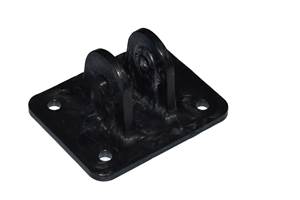Composite truck component carrier from Lanxess wins GKV/TecPart Innovation Award
Injection-molded glass fiber-reinforced PA6 component is jointly developed with system supplier and truck manufacturer for 35% less weight, replaces DLFT-based design.
This truck component carrier made from a Lanxess PA6 compound has won the 2022 GKV/TecPart Innovation Award presented by Verband Technische Kunststoffprodukte e.V. Photo Credit: BBP Kunststoffwerk Marbach Baier
A truck component carrier made from a (Cologne, Germany) polyamide 6 (PA6) compound has won the 2022 GKV/TecPart Innovation Award presented by (Frankfurt, Germany) at K Show in Düsseldorf, Germany. The structural component, jointly developed by (Marbach am Neckar, Germany), Lanxess and an unnamed German commercial vehicle manufacturer is a Durethan BKV35H2.0 901510 PA6 compound reinforced with 35 weight percent short glass fibers.
“Our material and our comprehensive process and structural simulations have helped to ensure that the carrier does not have to be reinforced with heavy and expensive metal inserts, in contrast to a direct long fiber thermoplastic [DLFT] composite design variant based on polypropylene,” Dr. Matthias Theunissen, an expert in lightweight design in plastics application development at Lanxess, says. “As a result, the component is around 35% lighter and much cheaper to manufacture.”
The component carrier is used in multiple truck models and takes the form of a trough with a cover. It is fastened to just four points at the center of the truck’s ladder frame and performs a number of tasks. For example, it holds two batteries weighing 75 kilograms each, as well as three compressed-air tanks, each of which tips the scales at around 7 kilograms. The structural component is exposed to considerable acceleration forces of approximately 1.2 million kilometers over a vehicle service life. These dynamic forces, plus the high weight of the entire assembly and the small number of fastening points, mean that it is subject to significant mechanical loads, Lanxess notes.
To obviate the need for costly metal reinforcement, BBP and Lanxess worked together to devise concept ideas for a purely injection-molded component that would be capable of withstanding high dynamic loads. In addition to design proposals, Lanxess contributed its expertise in simulations for structural component design. One particular challenge along the way was fastening the component to just a few points on the ladder frame and designing these fastenings to be capable of bearing the necessary loads.
Horst Hauke from BBP (right) and Matthias Theunissen (left) from Lanxess receive the award for the jointly developed innovative truck component carrier. Photo Credit: Lanxess
“When we were making the calculations, we had the benefit of being able to draw on our extensive process expertise in matters of injection molding. For example, we used a process simulation to determine how the short glass fibers orient themselves locally during injection molding, which leads to direction-dependent mechanical component properties,” Frank Lutter, CAE specialist, Lanxess, explains. “We then fed the data from that into the structural simulation, which helped to make precise predictions about the mechanical behavior of the component and, in turn, to optimize it.”
Injection molding the carrier is said to offer a number of advantages over DLFT-based manufacturing. For example, fiber orientation, wall thickness and warpage are all easier to reproduce. Production also lends itself better to automation, and cycle times are shorter and more efficient.
Related Content
Hybrid process marries continuous, discontinuous composites design
9T Labs and Purdue applied Additive Fusion Technology to engineer a performance- and cost-competitive aircraft bin pin bracket made from compression-molded continuous and discontinuous CFRTP.
Read MoreInfinite Composites: Type V tanks for space, hydrogen, automotive and more
After a decade of proving its linerless, weight-saving composite tanks with NASA and more than 30 aerospace companies, this CryoSphere pioneer is scaling for growth in commercial space and sustainable transportation on Earth.
Read MoreWelding is not bonding
Discussion of the issues in our understanding of thermoplastic composite welded structures and certification of the latest materials and welding technologies for future airframes.
Read MoreCarbon fiber composite pallet revolutionizes freight industry
LOG Point Pallet fuses advanced materials with innovative design and manufacturing to improve supply chains worldwide.
Read MoreRead Next
Lanxess equips SUVs with Tepex dynalite underbody paneling
Robust thermoplastic panels are 30% lighter than steel designs, features higher resistance to stone impacts or other damage, indicating future applications in electric-, hydrogen-powered vehicles.
Read MoreAll-recycled, needle-punched nonwoven CFRP slashes carbon footprint of Formula 2 seat
Dallara and Tenowo collaborate to produce a race-ready Formula 2 seat using recycled carbon fiber, reducing CO2 emissions by 97.5% compared to virgin materials.
Read MoreVIDEO: High-volume processing for fiberglass components
Cannon Ergos, a company specializing in high-ton presses and equipment for composites fabrication and plastics processing, displayed automotive and industrial components at CAMX 2024.
Read More












